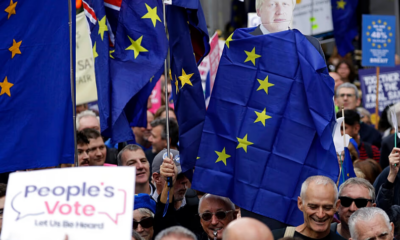Business
Trump Announces Sweeping Tariffs on Pharmaceuticals, Furniture, and Trucks

President Donald Trump on Thursday unveiled a sweeping set of new tariffs that could significantly affect household goods, healthcare costs, and the broader U.S. economy. Starting October 1, the administration plans to impose a 100% import tax on pharmaceutical drugs, a 50% duty on kitchen cabinets and bathroom vanities, 30% on upholstered furniture, and 25% on heavy trucks.
The announcement, made through posts on Trump’s Truth Social platform, signals the president’s continued reliance on tariffs as a cornerstone of his economic strategy. Trump argued that the measures are intended to reduce the federal budget deficit and boost domestic manufacturing, but offered limited legal justification. He claimed the tariffs were necessary “for national security and other reasons,” particularly with respect to cabinetry and furniture.
Under the Trade Expansion Act of 1962, the administration has already launched national security investigations into imports of pharmaceutical drugs and heavy trucks. A separate inquiry into timber and lumber began in March, though it remains unclear whether this directly relates to the new furniture tariffs.
Economists warn that the measures could inject more volatility into an economy already grappling with high inflation and slowing job growth. Federal Reserve Chair Jerome Powell recently cautioned that goods prices are driving much of this year’s inflationary pressure. “We have begun to see goods prices showing through into higher inflation,” Powell said, noting that the trend could worsen with additional import costs.
Healthcare groups and trade organizations reacted with alarm to the pharmaceutical announcement. The U.S. imported nearly $233 billion worth of medicines in 2024, according to Census Bureau data. Doubling prices on many of those products could raise costs for patients, Medicare, and Medicaid. Pascal Chan of the Canadian Chamber of Commerce warned of “immediate price hikes, strained insurance systems, hospital shortages, and the real risk of patients rationing or foregoing essential medicines.”
Trump said the pharmaceutical tariffs would not apply to companies building factories in the U.S., describing this as either projects that have broken ground or are under construction. However, it is unclear how the rule would apply to firms already producing in the country.
The president defended tariffs on heavy trucks as a measure to protect U.S. manufacturers such as Peterbilt, Kenworth, Freightliner, and Mack Trucks. “Large Truck Company Manufacturers…will be protected from the onslaught of outside interruptions,” he wrote.
While Trump has insisted tariffs spur investment in U.S. factories, federal data paints a more complex picture. Since April, manufacturers have cut 42,000 jobs, while construction firms have reduced payrolls by 8,000.
The announcement also comes ahead of a Supreme Court review in November over Trump’s use of emergency powers to impose broad tariffs under a 1977 law—a strategy that two lower courts ruled exceeded presidential authority.
Despite signs of economic strain, Trump maintains that his policies are succeeding. “There’s no inflation,” he told reporters Thursday. “We’re having unbelievable success.”
Business
Silver Surges Past $60 as Supply Strains, Rate Expectations and Tariff Concerns Drive Rally

Silver prices have surged to levels not seen before, rising above $60 an ounce this week after months of rapid gains driven by tightening supply, shifting Federal Reserve expectations and uncertainty around potential US trade actions. The metal hovered near $62 on Wednesday, extending a rally that began early this year when prices averaged around $30.
The latest jump came ahead of the Federal Reserve’s meeting, where investors expect another cut to the benchmark interest rate. The timing of the central bank’s leadership transition has added another layer of speculation. The US administration is reviewing finalists to replace Jerome Powell as chair, with Kevin Hassett, a senior economic adviser during Donald Trump’s presidency, reported to be the leading contender.
Market analysts say the candidates under consideration favour sharper rate reductions than those overseen by Powell. Since September, the Fed has trimmed rates twice by a quarter point each time. The gentler pace of easing has already pressured returns on cash and fixed-income assets, prompting many investors to shift into precious metals, which typically attract interest when rates fall. Silver, which does not generate yield, becomes more appealing in such an environment. Its performance has even outpaced gold, which has risen about 60 percent this year to reach record highs.
At the same time, traders are monitoring signals from Washington about whether silver could be targeted with tariffs. The metal was added in early November to the US government’s 2025 Critical Minerals List, a classification usually applied to resources seen as essential for national economic security. The designation places silver within the range of potential Section 232 investigations, the mechanism used in past years to justify tariffs on imported steel and aluminium.
Section 232 allows restrictions on imports deemed to put the country at risk through heavy dependence on overseas supply. No investigation has been launched, and officials have not indicated that tariffs are imminent. Still, the possibility has unsettled markets. Any duties on imported silver could reshape trade patterns and raise costs for domestic manufacturers, leading some buyers to boost inventories as a precaution.
Industrial use is also adding upward pressure. Demand from electric vehicle and solar panel manufacturers continues to rise, with these sectors relying on silver for components essential to production. Industrial consumption represents more than half of global silver use, and the combination of tight supply and strong manufacturing needs has intensified the rally.
Analysts say the market remains highly sensitive to signals from the Fed and the White House, with both interest-rate policy and trade decisions poised to shape the direction of prices in the months ahead.
Business
US Allows Nvidia to Sell H200 Chips to Approved Chinese Customers With 25% Surcharge
Business
Gold Looks to 2026 After a Record-Breaking Year Marked by Geopolitical Tension and Strong Central Bank Demand
-

 Entertainment1 year ago
Entertainment1 year agoMeta Acquires Tilda Swinton VR Doc ‘Impulse: Playing With Reality’
-

 Business2 years ago
Business2 years agoSaudi Arabia’s Model for Sustainable Aviation Practices
-

 Business2 years ago
Business2 years agoRecent Developments in Small Business Taxes
-

 Home Improvement1 year ago
Home Improvement1 year agoEffective Drain Cleaning: A Key to a Healthy Plumbing System
-

 Politics2 years ago
Politics2 years agoWho was Ebrahim Raisi and his status in Iranian Politics?
-

 Business1 year ago
Business1 year agoCarrectly: Revolutionizing Car Care in Chicago
-

 Sports1 year ago
Sports1 year agoKeely Hodgkinson Wins Britain’s First Athletics Gold at Paris Olympics in 800m
-

 Business1 year ago
Business1 year agoSaudi Arabia: Foreign Direct Investment Rises by 5.6% in Q1





























